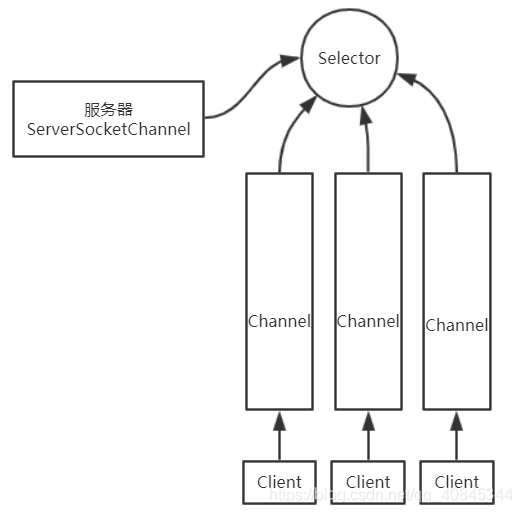NIO之ByteBuffer与Channel
传统IO:byte[] <= inputStream <= 文件 => outputStream => byte[]
NIO:文件 => inputChannel <=> buffer <=> outputChannel => 文件文件 <= inputChannel <=> outputChannel => 文件
- 文件复制, 并测试ByteBuffer常用API
position: 当前指针位置; limit: 当前内容的最大位置(例如: buffer内容为"hello", 容量为20, limit就是5); capacity: 最大容量
/*** 测试Buffer的position, limit, capacity, clear, flip* @author regotto*/
public class NioTest1 {/*** 下面的代码中, clear与flip效果一样.* 没有clear,flip,position的位置将会一直等于limit, 根据各属性之间的大小关系, position一定不会大于limit, * 所以在下面的read中, 读取到的值将一直都是0(代表当前读取到的位置), read一直不会等于-1, 代码出现死循环* @param args* @throws Exception*/public static void main(String[] args) throws Exception {FileChannel inputChannel = new FileInputStream("input.txt").getChannel();FileChannel outputChannel = new FileOutputStream("output.txt").getChannel();ByteBuffer buffer = ByteBuffer.allocate(4);while(true){//此处不进行clear, 此时position还是处于limit的位置, read将一直保持当前位置出现//死循环buffer.clear();int read = inputChannel.read(buffer);System.out.println("read: " + read);if (-1 == read){break;}//重置bufferbuffer.flip();outputChannel.write(buffer);}inputChannel.close();outputChannel.close();}
}
clear, flip源码如下:
public final Buffer clear() {position = 0;limit = capacity;mark = -1;return this;}public final Buffer flip() {limit = position;position = 0;mark = -1;return this;}
- DirectByteBuffer
ByteBuffer.allocate(1024) => HeapByteBuffer, 内部使用的就是byte[], 底层源码如下
public static ByteBuffer allocate(int capacity) {if (capacity < 0)throw new IllegalArgumentException();return new HeapByteBuffer(capacity, capacity);}//HeapByteBuffer extends ByteBuffer//ByteBuffer构造函数如下:ByteBuffer(int mark, int pos, int lim, int cap, // package-privatebyte[] hb, int offset){super(mark, pos, lim, cap);this.hb = hb;this.offset = offset;}
HeapByteBuffer位于JVM堆空间, 当使用HeapByteBuffer进行内容复制时, 存在2个复制过程: 应用程序 => 应用程序缓冲区 => 内核缓冲区 => 文件; 这种情况下, 2个复制过程存在一定的性能问题;
ByteBuffer.allocateDirect(1024) => DirectByteBuffer, DirectByteBuffer使用native方法创建数组, 数组不再位于JVM的Heap中, 而是位于内核内存中, 这样就避免了一次数据拷贝(拷贝的原因在于JVM中数据的地址会改变, 在GC下): 应用程序缓冲区 -> 内核缓冲区; 所谓的零拷贝, 加快速度, C/C++开辟的数组空间都是位于内核缓冲区
DirectByteBuffer底层源码:
public static ByteBuffer allocateDirect(int capacity) {return new DirectByteBuffer(capacity);}//unsafe中底层内存分配base = unsafe.allocateMemory(size);public native long allocateMemory(long var1);
使用DirectByteBuffer进行文件复制:
/*** 测试DirectByteBuffer* @author regotto*/
public class NioTest2 {public static void main(String[] args) throws Exception {FileChannel inputChannel = new FileInputStream("input.txt").getChannel();FileChannel outputChannel = new FileOutputStream("output.txt").getChannel();ByteBuffer buffer = ByteBuffer.allocateDirect(4);while(true){buffer.clear();int read = inputChannel.read(buffer);System.out.println("read: " + read);if (-1 == read){break;}buffer.flip();outputChannel.write(buffer);// buffer.flip();}inputChannel.close();outputChannel.close();}/*** 进行文件复制*/public void test() throws Exception {FileChannel fisChannel = new FileInputStream("text1.txt").getChannel();FileChannel fosChannel = new FileOutputStream("text2.txt").getChannel();//transferTo与transferFrom效果一样fisChannel.transferTo(0, fisChannel.size(), fosChannel);fisChannel.close();fosChannel.close();}
}
- 使用堆外内存进行文件内容复制(使用块内存提高性能)
/*** 测试MappedByteBuffer* 使用堆外内存对文件内容进行修改* @author regotto*/
public class NioTest3 {public static void main(String[] args) throws Exception{//下面的0, 4代表从0号位开始,将4个大小的空间映射到堆外内存MappedByteBuffer mappedByteBuffer = new RandomAccessFile("input.txt", "rw").getChannel().map(FileChannel.MapMode.READ_WRITE, 0, 4);mappedByteBuffer.put(0, (byte) 'a');mappedByteBuffer.put(0, (byte) 'a');mappedByteBuffer.put(0, (byte) 'a');}
}
NIO之网络IO
使用NIO进行网络非阻塞式编程, NIO编程模型图:

Selector: 检测Channel是否存在事件发生
ServerSocketChannel: 服务器
Channel: 管道
Client: 客户端
NIO网络编程结构图:

selectionKey的4种状态:OP_ACCEPT: 网络已连接 value = 16OP_CONNECT: 连接已建立 value = 8OP_READ OP_WRITE: 读/写操作, value = 1 或value = 4
根据上面结构图编写简单案例代码:
NioServer
/*** server*/
public class NioServer {public static void main(String[] args) throws IOException, InterruptedException {ServerSocketChannel serverSocketChannel = ServerSocketChannel.open();serverSocketChannel.configureBlocking(false);serverSocketChannel.bind(new InetSocketAddress(9999));Selector selector = Selector.open();SelectionKey selectionKey = serverSocketChannel.register(selector, SelectionKey.OP_ACCEPT);while (true) {//设置selector监控, 监控Channel的连接情况, 此处除去第一次的ServerSocketChannel注册, 监控时长2sif (selector.select(2000) == 0) {System.out.println("------当前没有要处理的Channel, 我去处理其他事------");TimeUnit.SECONDS.sleep(1);continue;}//此时有Channel进行连接, 获取selectedKeys, 处理每一个Channel的对象事件Set<SelectionKey> selectionKeys = selector.selectedKeys();selectionKeys.forEach(key -> {if (key.isAcceptable()) {System.out.println("OP_ACCEPT");//说明此处的key对应的是最开始前面register的ServerSocketChannelServerSocketChannel server = (ServerSocketChannel) key.channel();//此处对象的hash值相同System.out.println("(ServerSocketChannel) key.channel(): " + server.hashCode());System.out.println("ServerSocketChannel.open(): " + serverSocketChannel.hashCode());try {SocketChannel socketChannel = serverSocketChannel.accept();socketChannel.configureBlocking(false);//此处注册的时候就附加一个缓冲区, 可用于传输对象//当执行register的时候, 就会生成一个对应的SelectionKey事件, 当前的selectionKeys遍历完成, 就会将该selectionKey添加到set集合中SelectionKey socketChannelReadRegister = socketChannel.register(selector, SelectionKey.OP_READ, ByteBuffer.allocate(1024));} catch (IOException e) {e.printStackTrace();}}if (key.isReadable()) {SocketChannel socketChannel = (SocketChannel) key.channel();ByteBuffer byteBuffer = (ByteBuffer) key.attachment();try {socketChannel.read(byteBuffer);System.out.println("客户端内容: " + new String(byteBuffer.array(), StandardCharsets.UTF_8));} catch (IOException e) {e.printStackTrace();}}//这里使用remove与下面使用clear效果一样, 都是清除当前已经执行过的Channel, 避免重复执行//当前的Channel对应的事件被处理过, 就不再被处理, 使用这种写法较为恰当selectionKeys.remove(key);});
// selectionKeys.clear();}}
}
NioClient
/*** client*/
public class NioClient {public static void main(String[] args) throws IOException, InterruptedException {SocketChannel socketChannel = SocketChannel.open();socketChannel.configureBlocking(false);if (!socketChannel.connect(new InetSocketAddress("127.0.0.1", 9999))) {//连接服务端失败, 使用finishConnect进行连接, 此处finishConnect非阻塞while (!socketChannel.finishConnect()) {System.out.println("连接同时, 干其他事情");TimeUnit.SECONDS.sleep(2);}}//return new HeapByteBuffer(capacity, capacity);
// ByteBuffer.allocate(1024);//return new HeapByteBuffer(array, offset, length);ByteBuffer buffer = ByteBuffer.wrap("hello world".getBytes(StandardCharsets.UTF_8));socketChannel.write(buffer);//此处阻塞, 若关闭连接, server会抛出异常System.out.println("进入睡眠");Thread.currentThread().join();}
}Netty初窥门径
- Netty模型:

BossGroup: 处理客户端连接请求
WorkGroup: 处理网络读写操作
二者使用NioEventLoopGroup不断循环处理任务线程, NioEventLoopGroup内部都有一个selector, 监听每个Channel连接情况NioEventLoopGroup内部使用串行化设计: 消息读取->解码->处理->编码->发送
- NioEventLoopGroup模型:

一个NioEventLoopGroup包含多个NioEventLoop
一个NioEventLoop包含一个Selector, 一个任务队列
每个NioChannel都会绑定一个自己的ChannelPipeline
- ChannelPipeline模型:

ChannelPipeline: Handler集合, 负责处理/拦截inbound, outbound操作
ChannelHandlerContext: 事件处理器上下文对象, 内部包含每个具体的ChannelHandler, 也绑定对应Channel, pipeline信息
- 简单入门案例:
NettyServer:
/*** 服务器端*/
public class NettyServer {public static void main(String[] args) throws InterruptedException {EventLoopGroup bossGroup = new NioEventLoopGroup();EventLoopGroup workGroup = new NioEventLoopGroup();//线程池中任务队列数: ChannelOption.SO_BACKLOG, 128//让连接保持活动状态: ChannelOption.SO_KEEPALIVEServerBootstrap serverBootstrap = new ServerBootstrap().group(bossGroup, workGroup).channel(NioServerSocketChannel.class).option(ChannelOption.SO_BACKLOG, 128).childOption(ChannelOption.SO_KEEPALIVE, true).childHandler(new ChannelInitializer<SocketChannel>() {@Overrideprotected void initChannel(SocketChannel ch) throws Exception {ChannelPipeline pipeline = ch.pipeline();pipeline.addLast(new NettyServerHandler());}});ChannelFuture channelFuture = serverBootstrap.bind(9999).sync();channelFuture.channel().closeFuture().sync();bossGroup.shutdownGracefully();workGroup.shutdownGracefully();}}
NettyServerHandler:
public class NettyServerHandler extends ChannelInboundHandlerAdapter {@Overridepublic void channelRead(ChannelHandlerContext ctx, Object msg) throws Exception {ByteBuf byteBuf = (ByteBuf) msg;System.out.println("客户端发送的内容: " + byteBuf.toString(CharsetUtil.UTF_8));}/*** 数据读取完成* @param ctx Channel上下文对象* @throws Exception*/@Overridepublic void channelReadComplete(ChannelHandlerContext ctx) throws Exception {ctx.writeAndFlush(Unpooled.copiedBuffer("就是没钱", CharsetUtil.UTF_8));}@Overridepublic void exceptionCaught(ChannelHandlerContext ctx, Throwable cause) throws Exception {//出现异常, 直接关闭上下文对象ctx.close();}
}
NettyClient
/*** 客户端*/
public class NettyClient {public static void main(String[] args) throws InterruptedException {EventLoopGroup workGroup = new NioEventLoopGroup();Bootstrap bootstrap = new Bootstrap().group(workGroup).channel(NioSocketChannel.class).handler(new ChannelInitializer<SocketChannel>() {@Overrideprotected void initChannel(SocketChannel ch) throws Exception {ChannelPipeline pipeline = ch.pipeline();pipeline.addLast(new NettyClientHandler());}});ChannelFuture channelFuture = bootstrap.connect("127.0.0.1", 9999).sync();channelFuture.channel().closeFuture().sync();}
}
NettyClientHandler:
public class NettyClientHandler extends ChannelInboundHandlerAdapter {/*** 通道准备就绪, 当前已经连接* @param ctx* @throws Exception*/@Overridepublic void channelActive(ChannelHandlerContext ctx) throws Exception {ctx.writeAndFlush(Unpooled.copiedBuffer("老板, 还钱吧".getBytes(CharsetUtil.UTF_8)));}@Overridepublic void channelRead(ChannelHandlerContext ctx, Object msg) throws Exception {ByteBuf byteBuf = (ByteBuf) msg;System.out.println(byteBuf.toString(CharsetUtil.UTF_8));}
}



















